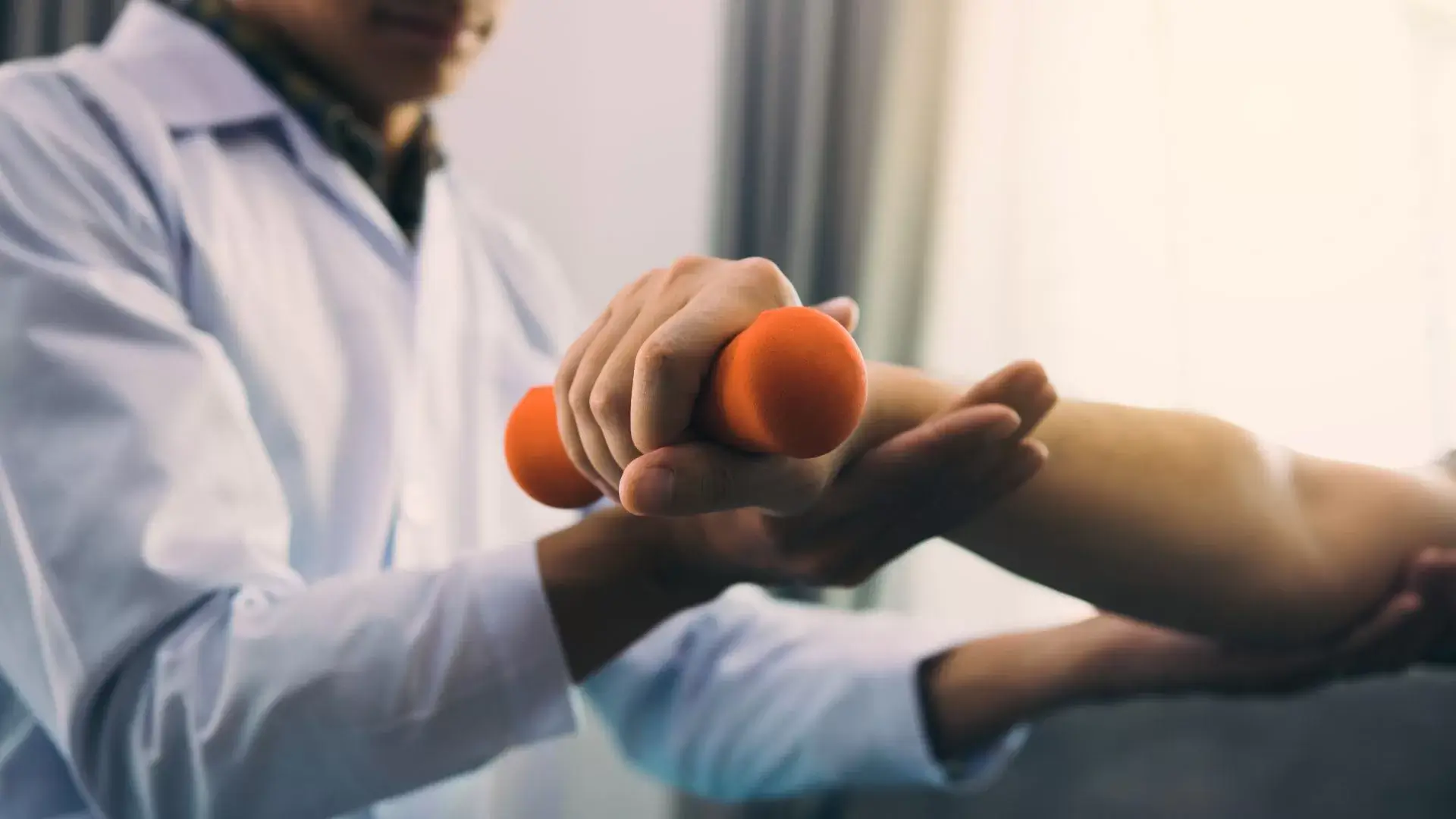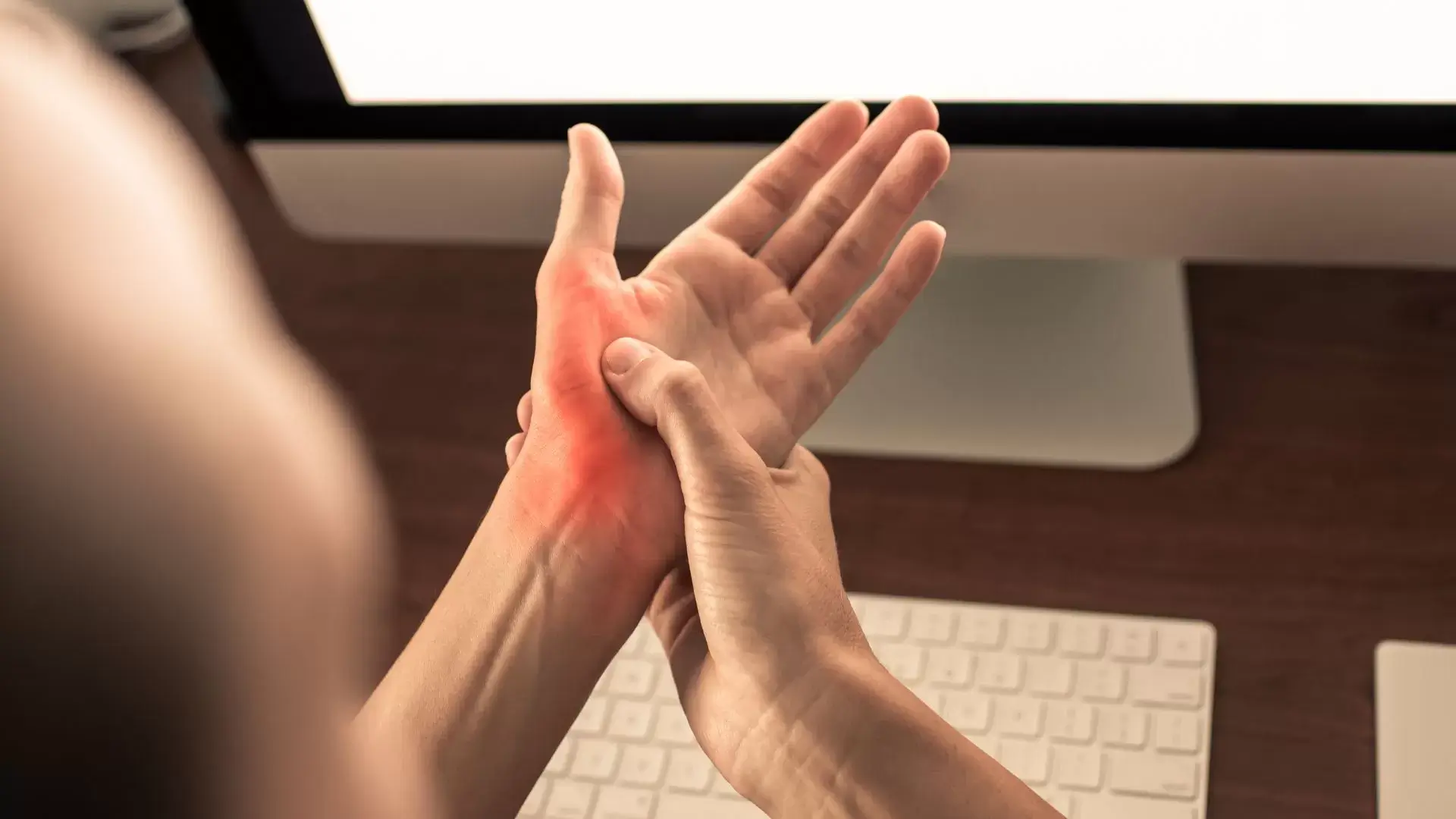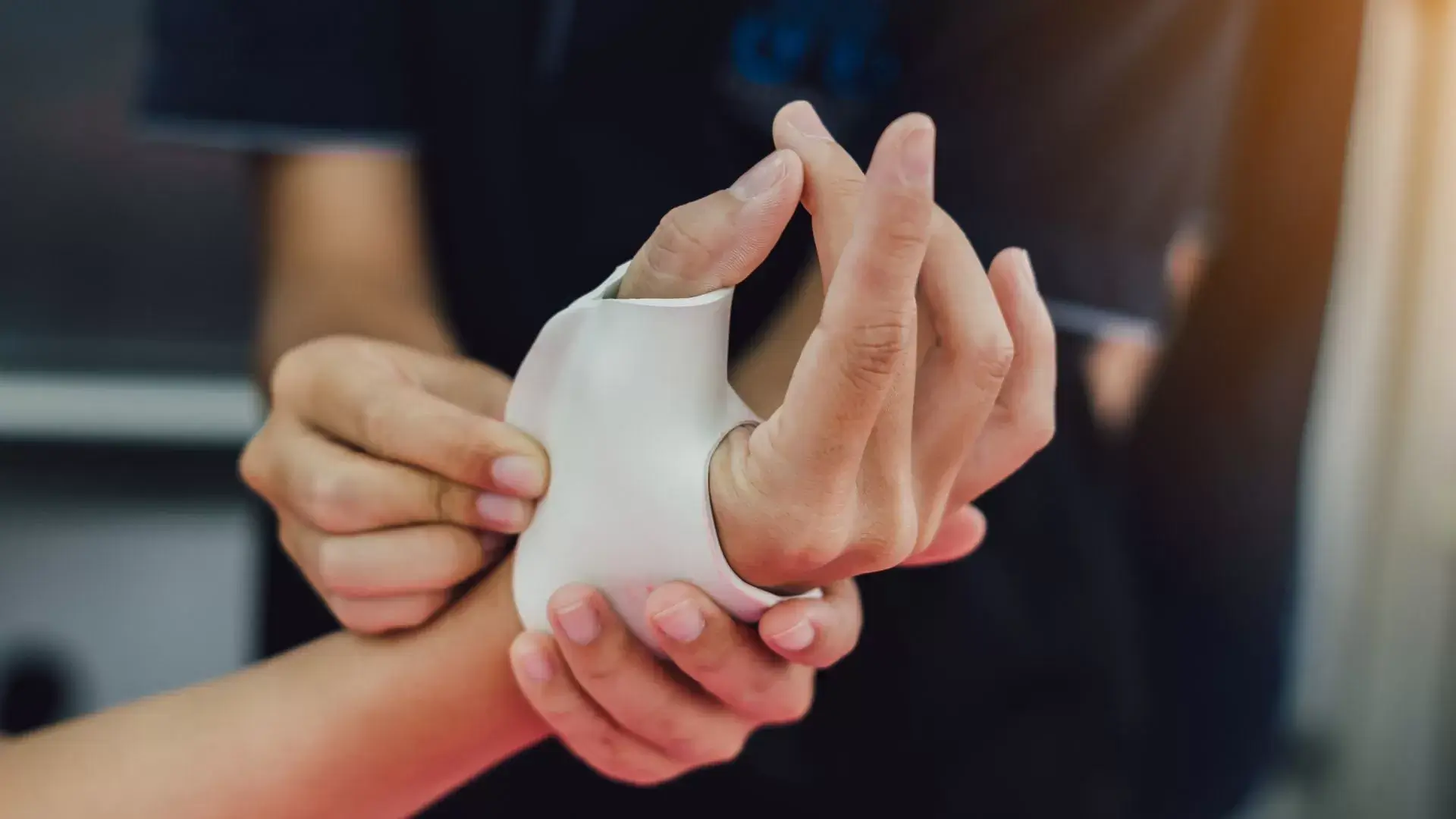We recognize that hand injuries can greatly impact your daily activities, and in Mississauga, we offer expert Physiotherapy for Hand Injury tailored to your unique needs. Our skilled physiotherapists in Mississauga provide personalized treatment plans that focus on pain management, rehabilitation, and restoring function. We utilize advanced modalities like ultrasound therapy, alongside strengthening and mobility exercises, to enhance recovery. With a compassionate approach, we empower you through education on proper ergonomics and self-care strategies. We’re dedicated to helping you regain your independence and quality of life. If you’re seeking insights on our extensive services, we invite you to explore further.

At Mississauga Physio Chiro Clinic, we offer a thorough range of physiotherapy and chiropractic services designed to effectively address hand injuries and promote ideal recovery. Our specialized team is committed to providing personalized care tailored to each patient’s unique needs, ensuring excellent outcomes in hand rehabilitation.
We understand that hand injuries can be debilitating, impacting daily activities and overall quality of life. That’s why our hand therapy programs incorporate a blend of physical therapy techniques, including pain management strategies and targeted exercises. Through a combination of range of motion exercises and hand strengthening exercises, we work to restore function and improve grip strength.
Additionally, we often utilize splinting to support recovery, allowing for better healing while minimizing discomfort. Our goal is to empower patients with the tools and knowledge they need to regain full use of their hands. By fostering a compassionate environment, we encourage open communication, ensuring that any concerns are addressed promptly. Together, we’ll navigate your recovery journey, helping you return to your daily activities with confidence and ease. Whether it’s a minor sprain or a more complex injury, we’re here to support you every step of the way.
Understanding the leading causes of hand injuries helps us better address the needs of our patients and tailor effective rehabilitation programs. Hand trauma can occur in various ways, often resulting in significant hand pain and functional limitations. Common causes include accidents at work or home, sports injuries, and repetitive strain injuries that arise from overuse.
Wrist injuries are frequently seen in falls or during activities that involve sudden movements. Finger and thumb injuries, such as dislocated fingers or tendon injuries, can occur during contact sports or when fingers get caught in machinery. Ligament injuries are also prevalent, particularly in situations where excessive force is applied to the hands.
In our practice, we often encounter patients dealing with sprained wrists, which can happen during falls or awkward landings. Each type of injury presents unique challenges, and understanding these causes allows us to implement targeted treatment plans. By focusing on the specific nature of the injury, whether it’s a tendon issue or a ligament strain, we can enhance recovery and help our patients regain their strength and mobility effectively.
Hand pain can considerably disrupt daily activities, making even simple tasks feel intimidating and frustrating for those affected. We often underestimate how essential our hands are until we experience issues like hand weakness, swelling, or stiffness. Activities such as buttoning a shirt, typing, or holding a cup can become challenging when pain interferes.
Conditions like tendonitis or nerve injury can result in not just discomfort but also hand numbness, limiting our ability to perform at work or enjoy leisure activities. Hand bruising or persistent swelling can further exacerbate feelings of inadequacy and helplessness.
For many, this pain can lead to a reduced range of motion, impacting mobility and overall quality of life. Engaging in occupational therapy can be invaluable, helping us regain function and learn adaptive strategies. In cases where conservative treatment fails, some might even face the prospect of hand surgery, which adds another layer of concern and recovery challenges.
It’s essential to acknowledge these difficulties, as they can affect our mental and emotional well-being. Seeking professional help can guide us toward relief and recovery, allowing us to reclaim our daily lives.
When hand injuries escalate to fractures or bone trauma, effective rehabilitation becomes essential for restoring function and alleviating pain. We recognize that whether it’s a hand fracture, wrist fracture, or a specific metacarpal or scaphoid fracture, each injury demands a tailored approach to recovery.
Our rehabilitation program focuses on several key components. Initially, we employ cold therapy to reduce swelling and pain, followed by heat therapy to promote blood flow and healing. As healing progresses, we integrate gentle exercises to regain strength and flexibility, ensuring we carefully monitor any scar tissue management to minimize long-term complications.
For patients who have undergone tendon or ligament repair, we emphasize a gradual return to full mobility, balancing rest and activity to avoid re-injury. Our compassionate team works closely with each individual, encouraging open communication to address concerns and adjust the rehabilitation plan as needed.

Effective physiotherapy solutions for tendon and ligament damage can greatly enhance recovery and restore functionality, allowing patients to regain their strength and confidence in everyday activities. We appreciate that tendon injuries, whether they involve flexor tendon injury or extensor tendon injury, can be debilitating. Our approach combines targeted hand therapy with personalized exercises to improve the range of motion and strengthen the affected areas.
For those dealing with ligament damage or wrist tendonitis, we utilize bracing techniques to support healing while minimizing discomfort. Our team focuses on restoring peak function through an all-encompassing rehabilitation plan that may include manual therapy, stretching, and strengthening exercises.
Additionally, we acknowledge the importance of addressing any associated nerve repair needs during hand rehabilitation. Our compassionate therapists work closely with each patient, providing them with the tools and knowledge to manage their recovery effectively. By incorporating these physiotherapy solutions, we aim to facilitate a smoother healing process, empowering individuals to return to their daily activities with confidence and resilience. Together, we can make significant strides in overcoming tendon and ligament injuries.
Nerve compression and injuries in the hand can considerably impact daily function, often occurring alongside tendon and ligament damage, making thorough treatment imperative for ideal recovery. Conditions like carpal tunnel syndrome, ulnar nerve entrapment, and median nerve injuries can lead to symptoms such as tingling in the hands, weakness, and discomfort.
In our physiotherapy practice, we focus on targeted interventions to alleviate pain and restore function. For instance, when addressing radial nerve injury or conditions like trigger finger and de Quervain’s tenosynovitis, we employ a combination of manual therapy, stretching, and strengthening exercises. These approaches help to relieve pressure on affected nerves and improve circulation.
Additionally, we educate our patients on ergonomic adjustments and activity modifications to prevent further injury. If hand arthritis or osteoarthritis is present, we also incorporate strategies to manage inflammation and enhance mobility, ensuring a thorough treatment plan.
Managing hand arthritis requires a multifaceted approach to reduce stiffness and enhance mobility, ensuring our patients can engage in daily activities with greater ease. We recognize that conditions like rheumatoid arthritis, along with complications from finger fractures or hand lacerations, can greatly impact hand function.
To address these challenges, we incorporate targeted exercises and manual therapy to alleviate stiffness and improve range of motion. For instance, specific techniques can help manage symptoms related to dupuytren’s contracture, mallet finger, and boutonniere deformity.
We also educate our patients on self-management strategies, such as using heat or cold therapy to reduce discomfort and inflammation. Patients with wrist instability or those experiencing issues from ganglion cysts benefit from tailored splinting techniques that support the hand while allowing for mobility.
Additionally, we remain vigilant about potential complications, such as hand infections, which can arise from injury or surgery. By taking a thorough approach, we empower our patients to regain their independence and enhance their quality of life despite the challenges posed by hand arthritis. Together, we can work towards achieving ideal hand function and comfort.
After hand surgery, it is crucial to implement targeted recovery strategies that promote healing and restore function, allowing us to support our patients on their journey to full rehabilitation. Depending on the type of injury, such as a sprained finger, dislocated wrist, or hand contusion, our approach may vary. For deep cuts and puncture wounds, we focus on scar management and gentle mobilization to prevent stiffness.
In cases like a boxer’s fracture or tfcc tear, we emphasize strength-building exercises while ensuring proper joint alignment. Recovery strategies for hyperextension injuries often include protecting the affected area with splints or braces and gradually introducing movement.
Additionally, we must consider conditions like de quervain’s tenosynovitis, where we might incorporate specific stretching and strengthening routines to alleviate pain. Each patient’s rehabilitation plan is tailored to their unique circumstances, taking into account their specific needs and the severity of their condition. By fostering a compassionate and supportive environment, we can empower our patients to take an active role in their recovery journey, ultimately leading to improved functionality and a return to their daily activities.

Repetitive strain and overuse injuries can greatly impact hand function, making specialized hand therapy essential for recovery and prevention. We frequently see patients dealing with conditions like de Quervain’s tenosynovitis and Dupuytren’s contracture, which arise from repetitive motions. These injuries, alongside others such as a jammed finger or a boxer’s fracture, can limit daily activities and cause significant discomfort.
In our physiotherapy sessions, we focus on techniques tailored to address various issues, including scapholunate injuries and the aftermath of crush injuries. We recognize that hand burns and cellulitis can also complicate recovery, requiring an integrated approach to rehabilitation. Our goal is to educate patients about proper ergonomics and body mechanics to prevent repetitive strain injuries (RSI) from worsening.
Through targeted exercises and modalities, we assist in restoring strength and mobility. It’s important for us to create a supportive environment where patients feel comfortable discussing their concerns. Together, we can develop a thorough treatment plan that not only aids in recovery but also enhances overall hand function, empowering individuals to return to their daily activities with confidence.
Enhancing hand function through occupational therapy involves a thorough approach that focuses on improving daily activities and overall quality of life for our patients. At our clinic located at 1834 Lakeshore Rd W #6C, Mississauga, ON L5J 1J7, we recognize the unique challenges faced by individuals dealing with conditions like de Quervain’s tenosynovitis, Dupuytren’s contracture, or recovering from an amputated finger.
Our skilled team works collaboratively to create personalized treatment plans that include exercises, adaptive techniques, and ergonomic assessments. For patients with injuries such as a boxer’s fracture, Bennett’s fracture, or a Rolando fracture, we emphasize regaining strength and mobility to facilitate a return to normal activities.
We also address complications like septic arthritis, which can hinder recovery. By focusing on functional tasks, we help our patients develop the necessary skills to perform everyday activities with ease. If you’re seeking support, don’t hesitate to contact us. Together, we can enhance your hand function and improve your overall quality of life, ensuring you regain the independence you deserve.
To support our patients in their recovery journey, we often incorporate bracing and splinting strategies that stabilize the hand and promote healing while allowing for gradual mobility restoration. These supportive devices play an essential role in managing pain and minimizing additional injury during the rehabilitation process.
When we assess a hand injury, we consider the specific type and severity, tailoring our approach to meet each patient’s unique needs. Depending on the injury, we might recommend a rigid splint for complete immobilization or a more flexible brace that allows for some movement, striking a balance between support and mobility.
By using bracing and splinting, we help to alleviate pressure on injured structures, which can reduce inflammation and expedite the healing process. Moreover, these devices serve as reminders to avoid movements that could exacerbate the injury.
As our patients progress, we monitor their recovery closely, making adjustments to the bracing or splinting as necessary. Our goal is to empower our patients, ensuring they feel confident and informed about their recovery while providing the support they need to regain full function in their hands.
In our practice, we prioritize effective soft tissue healing and scar management techniques to support ideal recovery and restore function in injured hands. We recognize that injuries can lead to significant soft tissue damage, which can impede movement and cause discomfort. To promote healing, we often employ methods such as manual therapy, which enhances blood circulation and reduces swelling.
Additionally, we incorporate stretching and strengthening exercises tailored to each patient’s specific needs. These exercises help maintain flexibility and prevent stiffness in the affected area.
When it comes to scar management, we use a combination of techniques, including massage therapy and silicone gel sheeting. These methods can minimize scar tissue formation and improve the appearance and function of scars. We also emphasize the importance of patient education, ensuring that individuals comprehend how to care for their wounds and manage their rehabilitation effectively.
Effective pain relief strategies are essential for managing discomfort and facilitating recovery in patients with hand injuries. In our practice, we prioritize a multifaceted approach tailored to each individual’s needs. First, we often recommend the application of ice or heat therapy to reduce pain and inflammation. Ice can be particularly effective during the initial stages of injury, while heat may be beneficial in later phases to promote circulation.
Medications, both over-the-counter and prescription, may also play a role in managing pain. We encourage open communication with healthcare providers to determine the most suitable options. Additionally, we utilize modalities such as ultrasound therapy and electrical stimulation, which can provide significant relief for many patients.
We also emphasize the importance of rest and elevation to minimize swelling and discomfort. By combining these strategies, we can effectively support our patients in their journey toward recovery.
Ultimately, our goal is to create a compassionate environment where patients feel empowered and informed about their pain management options. Through collaboration and clear communication, we work together to enhance comfort and promote healing, ensuring a smoother recovery process for hand injuries.
Incorporating hand strengthening and mobility exercises into our rehabilitation program is essential for restoring function and enhancing recovery after a hand injury. These exercises not only improve strength but also help regain the range of motion, which is imperative for everyday activities.
We’ll start with simple range of motion exercises, like finger flexion and extension, to promote flexibility. Gradually, we can introduce exercises using putty or therapy balls to build strength. Activities such as squeezing a soft ball or performing finger abduction can greatly enhance the grip and dexterity of our hands.
It’s important to remember that consistency is key. We should aim to perform these exercises daily, gradually increasing the intensity as our strength improves. Listening to our bodies is crucial; if we experience pain, we should modify the exercises accordingly.
Incorporating stretches for the wrist and forearm will also help alleviate tension and improve overall mobility. By focusing on both strengthening and mobility, we’ll create a balanced approach to our recovery, ensuring we can return to our daily activities with confidence and ease. Together, we can navigate this journey to full recovery.
Finding expert physiotherapy for hand injuries in Mississauga can greatly enhance our recovery process, especially after engaging in targeted strengthening and mobility exercises. With the right professionals by our side, we’ll receive tailored treatment plans that address our unique needs, ensuring we regain ideal functionality.
In Mississauga, skilled physiotherapists specialize in hand injuries, combining their knowledge of anatomy with hands-on techniques to facilitate healing. They’ll guide us through thorough assessments to identify the specific nature of our injury, allowing for precise interventions. This personalized approach not only accelerates recovery but also helps prevent future complications.
Moreover, these experts are equipped with advanced modalities, such as ultrasound therapy or electrical stimulation, which can appreciably reduce pain and inflammation. They’ll also educate us on proper ergonomics and strategies to adapt our daily activities, fostering long-term health and resilience.
The compassionate care we receive throughout our journey can make a world of difference. By choosing expert physiotherapy, we’re not just investing in our recovery; we’re committing to reclaiming our independence and enhancing our quality of life. Let’s take that important step towards healing together in Mississauga.
Located in the heart of the Greater Toronto Area, Mississauga offers a vibrant community rich in culture, diversity, and opportunity for both residents and visitors alike. With a population exceeding 700,000, we’re one of Canada’s largest cities, and our multicultural makeup is reflected in the array of festivals, restaurants, and businesses that line our streets.
Mississauga is home to numerous parks, recreational facilities, and waterfront spaces along Lake Ontario, providing us with plenty of options for outdoor activities and relaxation. Our city boasts a robust economy, featuring major corporations and thriving local businesses, which contribute to the community’s overall prosperity.
In addition to its economic strengths, Mississauga prioritizes healthcare and wellness, with access to various medical services, including physiotherapy. For those of us recovering from hand injuries, the availability of specialized care guarantees that we can regain our strength and mobility effectively.
As we continue to grow, Mississauga remains committed to fostering an inclusive environment where everyone can thrive, making it an ideal place to live, work, and seek rehabilitation services.

When we’re searching for a hand physiotherapist, we should prioritize their qualifications and experience. It’s important they hold a relevant degree in physiotherapy and are registered with the appropriate regulatory body. We should also look for specialization in hand therapy or related fields. Additionally, having advanced certifications and hands-on experience with similar injuries can be invaluable. Compassionate communication and a personalized approach are essential for our recovery journey.
When it comes to hand injury rehabilitation, it usually takes anywhere from a few weeks to several months. The duration often depends on the severity of the injury and our commitment to the rehabilitation process. We’ve found that following a structured therapy plan and staying consistent with exercises can greatly speed up recovery. It’s crucial to communicate with our healthcare provider to guarantee we’re on the right track and make adjustments as needed.
When recovering from a hand injury, it’s essential we avoid certain exercises that can hinder our healing process. High-impact activities, heavy lifting, and any movements that cause pain should be off-limits. We should also steer clear of exercises that require gripping or twisting, as these can strain our injured areas. Instead, focusing on gentle range-of-motion exercises will help promote recovery without risking further injury. Always consult our healthcare provider for personalized guidance.
When it comes to insurance coverage for physiotherapy, we recognize it can be a bit confusing. Most insurance plans do cover physiotherapy, but specifics can vary greatly. We recommend checking with our insurance provider to see what’s included in our plan. Additionally, we should confirm if there are any limits on sessions or coverage for specific conditions. We’re here to help navigate this process and guarantee we get the care we need.
To support our recovery at home, we can start by resting the affected area and applying ice to reduce swelling. Gentle stretching and strengthening exercises can help improve mobility, but we should listen to our bodies and not push too hard. Keeping our hand elevated can also aid in reducing inflammation. Additionally, maintaining a balanced diet rich in vitamins and minerals will support healing. Consistency and patience are key as we progress.
Reach out to us today to book an appointment or learn more about our services. Our friendly team is here to answer your questions and help you take the first step toward improved health and wellness.
(647) 372-1209

At our Mississauga Physio Chiro Clinic, we are dedicated to providing personalized care that addresses the root cause of your discomfort. With a team of experienced physiotherapists and chiropractors, we focus on restoring your mobility, relieving pain, and enhancing your overall well-being.